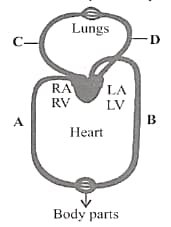Double Circulation
Double Circulation: Overview
This topic covers concepts such as Double Circulation, Systemic Circulation, Hepatic Portal System, etc.
Important Questions on Double Circulation
Which one of the following vertebrate organs receives the oxygenated blood only?
Which of the following does not contribute to increased stroke volume during exercise?
Study the following table:
| Part of heart | Location | Function | |
| A | Fossa ovalis | Interatrial septum | Directs blood from right atrium to left atrium |
| B | sinoatrial node | Wall of the right atrium | Initiation of systole |
| C | Atrio-ventricular node | Interventricular septum | Acts as pacemaker |
| D | Bicuspid valve | Left atrioventricular aperture | Directs blood to flow from left atrium to left ventricle |
Assertion (A): In human heart, deoxygenated blood always flows from right ventricle into pulmonary arch only
Reason (R): Mitral valve present at the base of pulmonary arch prevents the reverse flow of blood
The following characteristic features of circulatory system and heart types were found different animals, and
A) deoxygenated and oxygenated bloods are received by the heart separately but mixed blood will be pumped out from the heart
B) the oxygenated and deoxygenated bloods are received by the heart and the unmixed blood is pumped out separately
i) double circulation and -chambered heart
ii) incomplete double circulation and -chambered heart
iii) double circulation and -chambered heart
iv) incomplete double circulation and -chambered heart
Which of the following condition is correct?
The hepatic portal vein drains blood to the liver from;
Hepatic portal vein is found in
A portion of the cardiovascular system that transports oxygen-depleted blood from the heart to the lungs and brings oxygenated blood back to the heart is referred as
In which of the following is the maximum urea levels present?
Where does the blood from head, neck and arms enter next through the heart?
Read the following statements and select the appropriate option:
Statement I: A portal vein does not carry blood directly to heart but forms a network of capillaries in another or intermediate organ before reaching the heart.
Statement II: Hepatic and hypophyseal portal systems are present in humans.
*Note: The corrected spelling of "hypophyseal" has been updated in the question.
Identify the incompatible option from the following:
What happens during pulmonary circulation?
Identify the correct statement from the following:
(i) Vasa vasorum are small blood vessels that supply thicker vessel walls.
(ii) In higher vertebrates, the systemic heart refers to the left atrium and left ventricle.
(iii) During strong atrial contraction, chordae tendinae avoid bulging of the AV valves into ventricles.
(iv) Stimulation of the nerve of the vagus raises the heart rate.
Choose the wrong statement from the following:
Read the following four statements (A-D) and select the number of the wrong statement(s).
(A) In amphibia and reptiles complete double circulation is absent.
(B) In arthropods and molluscs closed circulatory system absent.
(C) In joint diastole stage, the semilunar valves are closed.
(D) The hepatic portal vein carries blood from intestine to the kidney.
Blood received by the right atrium and left atrium respectively are
Given below is the figure showing double circulation in humans. Which of the following correctly matches the nature of blood passing through A, B, C, and D?

Given below are the structures associated with the circulatory system of humans.
1. Atrioventricular valves
2. Semilunar valves
3. Right atrium
4. Right ventricle
5. Pulmonary artery
The correct sequence of movement of blood cells during pulmonary circulation is
